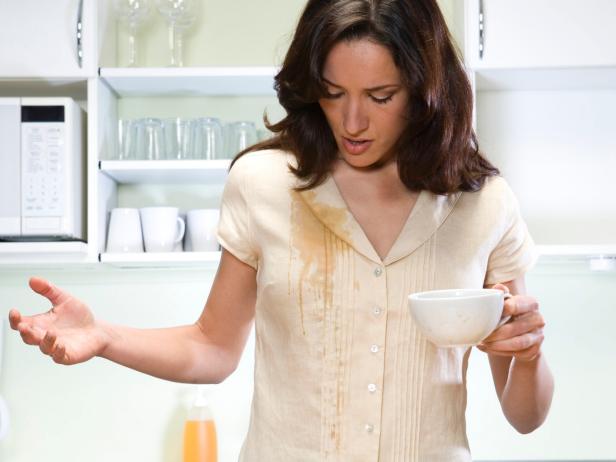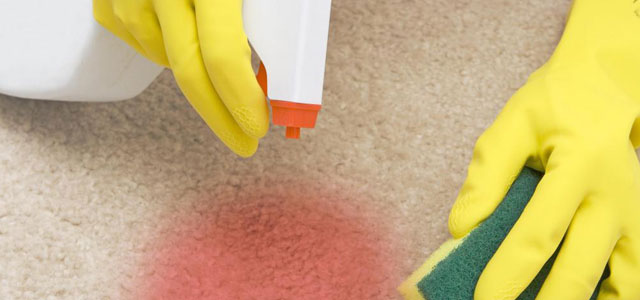 Stains can disfigure a favorite dress, carpets, curtains and more. It is important to remove stains as soon as possible – and before they are allowed to set. Here are some simple techniques and solutions for stain removal.
Stains can disfigure a favorite dress, carpets, curtains and more. It is important to remove stains as soon as possible – and before they are allowed to set. Here are some simple techniques and solutions for stain removal.
The first important thing to do is to identify the stain by close observation:
- Color – For example, the red coloring of a lipstick stain; the brown coloring of an iodine stain.
- Form – For example, ink will penetrate right into the fabric while paint will build up on the surface.
- Odour – This if often a tell-tale sign that may identify perfume or medicinal stains.
- Location – For example, perspiration stains in the underarm areas of a suit or shirt.
- Feel – Glue and adhesives are sticky; egg is stiff.
If you still feel you do not know what the stain is, soak the stain in cold water and rub the stain to remove it. Another method of stain identification may be to take the stained item to a drycleaner and have it identified there.
Precautions to Keep in Mind
- Treat the stain promptly – even before it dries if possible.
- When using any stain remover on coloured clothes, experiment on a seam or an inconspicuous spot first.
- Always work from the underside of the stain to avoid driving the stain through the fabric.
- Avoid ironing or machine drying stained fabrics. The heat from the iron/dryer may cause stains to become permanently set.
- Remove as much of a built-up stain as possible by scraping, before applying any spotting fluid.
- Spotting is done by placing a pad of clean soft, white cloth under the stain and rubbing gently with cheesecloth dampened with spot remover. Use light strokes and work with the grain of the fabric.
- Follow the directions on the container of the stain remover. Too much may damage or discolour fabric.
Kinds of Stain Removers
 Absorbents – Include such things as cornstarch, cornmeal, powder, chalk or talc. These should be spread on the stain before it dries (or if it has already dried, wet the stained area). Remove the powder by brushing it off as it absorbs the stain.
Absorbents – Include such things as cornstarch, cornmeal, powder, chalk or talc. These should be spread on the stain before it dries (or if it has already dried, wet the stained area). Remove the powder by brushing it off as it absorbs the stain.
- Detergents – Soap and synthetic detergents will remove many non-greasy stains and some greasy stains.
- Solvents – Includes dry cleaning fluid and water. Be sure to test the solvent in an inconspicuous area of the fabric before use.
- Chemical Stain Removers – This includes bleaches, blueing, vinegar, iodine (for removing silver nitrate), oxalic acid (for removing rust and metallic stains – will damage silk) and sodium thiosulfate (for removing iodine and chlorine).
- Enzyme Containing Cleaners – These cleaners remove stains such as blood, grass, chocolate, lipstick, perspiration, grey, milk, eggs and body soil.
- Pre-wash Soil and Stain Removers – Used to pre-treat heavily soiled and stained areas.
Bleaches
- Oxygen Bleach – Very mild and safe to use on all fibers, whether colored or white. It should be used regularly as it is intended to prevent fabrics from becoming grey and dull rather than to restore whiteness and brightness.
- Chlorine Bleach – Very strong and must be used cautiously. It is used on white cottons, linens and some synthetics, but synthetics may yellow if chlorine bleach is used on them. Never use chlorine bleach:
on silk, wool, rayon, acetate, delicate fibers, spandex and colored items on resin-treated fabrics such as permanent press – may cause the fabric to yellow in areas where there is a lot of iron in the water or a rust condition in the pipes (will cause yellowing). - Reducing Bleaches – Are used to remove dyes, hard-to-remove stains from white goods and the yellow discoloration from some finishes.
Treatment of Specific Stains in alphabetical order
- Adhesive Tape, Chewing Gum, Rubber Cement – Apply ice to harden surface; scrape with a dull knife to remove excess. Saturate with a pre-wash stain remover or cleaning fluid. Rinse, then launder.
- Baby Formula – Pretreat or soak stain using a product containing enzymes; soak for 30 minutes up to several hours for aged stains. Launder.
- Beverages (coffee, tea, soft drinks, wine, alcoholic drinks) – Sponge stain promptly with cold water or soak stain in cool water for 30 minutes or longer. Pretreat with prewash stain remover, liquid laundry detergent, or a paste of powdered detergent and water. Launder with the bleach safe for that fabric. For aged stains, try soaking in warm water with an enzyme-containing product; launder.
- Blood – Treat as soon as possible. Soak in cold water for 30 minutes. Rub detergent into any remaining stain. Rinse, then launder. Dried stains should be pretreated or soaked in lukewarm water with a product containing enzymes, then laundered. Note: If stain remains, rewash, using a bleach that is safe for that fabric.
- Candle Wax – Apply ice to harden, then remove surface wax with a dull knife. Place between paper towels and press with a warm iron. Sponge remaining stain with a prewash stain remover or dry-cleaning fluid; blot with paper towels. Let dry, then launder. If any color remains, rewash with a bleach that is safe for that fabric.
- Carbon Paper – Rub detergent into dampened stain; rinse well. If stain is not removed, put a few drops of ammonia on the stain and repeat treatment with detergent; rinse well. If colourfasness is questionable, use hydrogen peroxide instead of ammonia. Launder as usual.
Chocolate and Cocoa – Treat the stain with a prewash spray or pretreat with a product containing enzymes. If stain remains, relaunder with bleach that is safe for that fabric. - Coffee, Tea (plain or with sugar/sweetener) – Flush stain immediately with cool water or soak for 30 minutes in cool water. Rub stain with detergent and launder with bleach that is safe for that fabric.
- Coffee, Tea (with cream only) – Sponge stain with a dry-cleaning solvent. Air dry. Rub with detergent, then launder in hottest water safe for that fabric (with bleach that is safe for that fabric). Pretreat or soak older stains with an enzyme product, then launder.
- Cosmetics – Pretreat with prewash stain remover, liquid detergent or a paste of powdered laundry detergent and water, or rub with bar soap. If greasy stain remains, soak in an enzyme product. Rinse and launder.
- Crayon (few spots) – Treat the same as for candle wax, or rub dampened stain with bar soap. Launder with hottest water safe for that fabric. For a whole load of clothes, wash in hottest water safe for fabric, using a laundry soap (not detergent) plus 250 ml baking soda. If colored stain remains, launder again, using chlorine bleach, if safe for fabric. Otherwise, pretreat or soak in a product containing enzyme or an oxygen bleach using hottest water safe for fabric, then launder.
- Dairy Products – Pretreat with prewash stain remover or soak in an enzyme product for 30 minutes if stain is new, or several hours for aged stains; launder.
- Deodorants, Antiperspirants – Treat light stains with a liquid detergent and then launder. Pretreat heavy stains with a prewash stain remover. Allow to stand 5 to 10 minutes. Launder, using an all-fabric bleach.
Dye Transfer (white garment that has picked up bleeding dye from other garment) – Remove stains with a commercial color remover; launder. If stain remains, launder again with chlorine bleach, if safe for that fabric. For colored fabrics and whites that cannot be chlorine bleached, soak in oxygen bleach or an enzyme product, then launder. - Egg – Pretreat with an enzyme product for 30 minutes for new stain, or several hours for aged stains; launder.
- Fabric Softener – Dampen stain and rub with bar soap. Rinse, then launder. If stain remains, sponge area with rubbing alcohol or dry-cleaning solvent. Rinse thoroughly and rewash.
- Fingernail Polish – Try nail polish remover, but do not use on acetate or triacetate. Place stain face down on paper towels and flush with remover. Replace paper towels regularly. Repeat until stain disappears; rinse and launder. Some polishes may be impossible to remove.
- Formula – Soak in cold water, then launder in as hot a water as fabric will permit, using suitable bleach.
- Fruit Juices and Berries – Soak garment in cool water. Wash with bleach that is safe for that fabric.
- Grass – Pretreat with prewash stain remover or soak with an enzyme product. If stain remains, and if safe for dye, sponge stain with rubbing alcohol (dilute alcohol with 2 parts water for use on acetate). If stain still remains, launder in hottest water safe for fabrics, with bleach that is safe for that fabric.
- Grease and Oil – Light stains can be pretreated with a prewash stain remover or liquid laundry detergent. Launder in hottest water safe for fabric. Place heavy stains face down on clean paper towels. Apply cleaning fluid to the back of stain. Let air dry; rinse. Launder in hottest water safe for that fabric.
- Ink – Ballpoint ink stains can be placed stain face down on white paper towels. Sponge with rubbing alcohol or dry-cleaning solvent, or rub detergent into stained area. Repeat if some stain remains. Rinse; launder. Drawing ink usually cannot be removed. Try flushing with cold water until ink colour is removed; rub liquid detergent into stain; rinse. Repeat process. Soak in warm sudsy water to which 15 to 60 ml of household ammonia per litre of water have been added. Rinse thoroughly. Launder in hottest water safe for that fabric, with bleach safe for the fabric.
- Felt Tip Ink – Usually cannot be removed. Try pouring water through the stain before it dries, until ink colour is removed. Allow to dry. If you notice some reduction in stain, sponge with dry-cleaning solvent. Allow to dry. Rub liquid household cleaner into stain. Rinse. Soak stain (possibly overnight) in warm water to which 15 to 60 ml of household ammonia have been added. Rinse and repeat treatment if necessary; launder.
- Iodine – Rinse from back side of stain under cool, running water. Soak in solution of color remover, or sponge with a solution of sodium thiosulfate crystals (available at drug store). Rinse and launder.
Ketchup/Tomato Sauce – Rinse in cold water, then soak in cool soapy water. Treat with a prewash product; launder with a bleach that is safe for that fabric. - Lipstick – Place face down on paper towels. Sponge area with dry-cleaning solvent, or use a prewash soil and stain remover. Replace towels frequently; rinse. Rub light-duty liquid detergent into stain until outline is removed; launder. Repeat if necessary.
- Liquid paper – Sponge stain with amyl acetate (banana oil). Air dry. Repeat if necessary. Rub gently with detergent, then launder.
- Mercurochrome or Methyolate – Rinse out as much of the stain as possible under cool, running water. Soak for 30 minutes in a solution of 3 ml ammonia per litre of water. Rinse; if stain remains, soak in a solution of 1 litre warm water and 15 ml vinegar for one hour. Rinse thoroughly and allow to dry. Launder with detergent and bleach. For delicate fabrics, apply alcohol and cover with pad moistened with alcohol. Rinse; launder.
- Mildew – Launder stained items with bleach that is safe for that fabric, using as hot as water as is safe for the fabric. If some stain remains, sponge with hydrogen peroxide. Rinse and relaunder. Dry in sunlight. Continued exposure to sunlight may assist in fading mildew stains, though may also fade colour. Badly mildewed fabrics may be damaged beyond repair.
- Mud – Let dry, then brush off as much mud as possible. For light stains, pretreat with a paste of powdered detergent and water, or liquid detergent; launder. Pretreat heavy stains by presoaking with laundry detergent, a product containing enzymes, or a container of water with 60 ml each of ammonia and liquid detergent; launder.
- Mustard – Treat with a prewash stain remover, or dampen with water and rub with bar soap. Launder with bleach safe for that fabric.
- Paint – Water-based paint, such as latex acrylic stains, should be rinsed in warm water while stain is still wet; launder. This stain usually cannot be removed after it dries. For oil-based paints, including varnish, use the solvent listed on the label as a thinner or turpentine. Rinse. Pretreat with prewash stain remover, bar soap, or detergent. Rinse and launder.
- Perfume – Treat with prewash stain remover or liquid laundry detergent; rinse and launder.
- Perspiration – Treat with prewash stain remover, or dampen stain and rub with bar soap. If the color of the fabric has changed slightly, apply ammonia to fresh stain or white vinegar to old stain; rinse. Launder in hottest water safe for that fabric. Stubborn stains may respond to pretreating with a product containing enzymes, then launder using an all-fabric bleach.
- Pine Resin – Sponge the stain with cleaning fluid; let dry. Rub with detergent and launder as usual. If stains persist, apply a few drops of household ammonia. Air dry. Launder, using liquid laundry detergent.
- Pollen – Sponge, then flush with dry-cleaning solvent. Let air dry. Rub gently with detergent. Launder using bleach that is safe for that fabric.
Ring Around the Collar – Rub area with a prewash stain removal product and let remain for 30 minutes, or longer for heavy stains. Launder.
- Rust – Apply a commercial rust remover. Follow manufacturer’s instructions. Do not use chlorine bleach on rust.
- Scorch – Launder with chlorine bleach, if safe for that fabric. Otherwise, soak in an all-fabric bleach and the hottest water safe for that fabric, then launder. Note: Badly scorched stains cannot be removed.
- Shoe Polish – Pretreat liquid shoe polish with a paste of granular detergent and water; launder. Use a dull knife to scrape residue of paste shoe polish from the fabric. Pretreat with a prewash stain remover or cleaning fluid; rinse. Rub detergent into dampened area. Launder with chlorine bleach, if safe for fabric, or an all-fabric bleach.
- Tar and Asphalt – Act quickly before stain dries. Use a dull knife to scrape excess tar from the fabric. Place stain face down on paper towels. Sponge with cleaning fluid. Launder, using hottest water safe for that fabric.
- Tobacco – Moisten stain and rub with bar soap; rinse. Pretreat with prewash stain remover or soak in an enzyme solution; launder. Note: If stain remains, launder again using chlorine bleach, if safe for fabric, or use oxygen bleach.
Urine, Vomit, Mucous, or Feces – Treat with prewash spray or pretreat with a product containing enzymes. Launder with chlorine bleach that is safe for fabric, or use an all-fabric bleach. - Yellowing of White Cottons or Linens – Fill washer with hot water. Add twice the detergent as normal. Place items in washer and agitate four minutes on regular cycle. Stop washer and soak clothes for 15 minutes. Restart washer and agitate 15 minutes. Complete the wash cycle. Repeat process if needed.
- Yellowing of White Nylon – Soak garment overnight in an enzyme presoak or oxygen bleach. Launder, using hot water and twice as much detergent as usual with an oxygen bleach.




